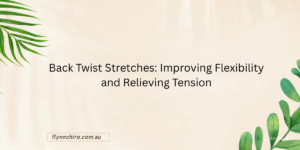
Can a Chiropractor Help with Bruxism?
Bruxism, the habit of grinding or clenching your teeth, can seem like a small problem at first. Many people don’t even realize they’re doing it especially if it happens while they sleep. But over time, this constant pressure can cause pain, headaches, tension, and damage to the teeth and jaw. It can also contribute to issues with the spine, posture, and overall musculoskeletal health.
While most people associate bruxism treatment with dentists, chiropractic care can actually play a major role in reducing the root causes of teeth grinding. Chiropractors don’t just focus on the teeth or jaw; they look at the entire body’s structure and how it functions together. This makes them well-suited to address the muscle tension, joint dysfunction, and nervous system imbalance that can contribute to bruxism.
In this article, we’ll explore how chiropractic care can help people struggling with bruxism, what to expect during treatment, and why combining chiropractic care with other approaches can deliver the best long-term results.
Understanding Bruxism and Its Impact on the Body
Bruxism is more than just an annoying habit it can be a sign that your body is under physical or emotional stress. People who grind or clench their teeth often do so unconsciously, especially at night. This repetitive pressure can cause inflammation and strain in the temporomandibular joint (TMJ), which connects the jawbone to the skull.
The TMJ is surrounded by muscles that also link to the neck, head, and shoulders. When this area is tight or misaligned, it can affect the posture of the head and spine. This is why many people with bruxism also complain of neck stiffness, shoulder tension, or even back pain.
Left untreated, bruxism can wear down tooth enamel, crack teeth, and lead to chronic jaw pain. It can also trigger frequent headaches, ringing in the ears, and difficulty opening or closing the mouth fully. Addressing the problem early can prevent this chain reaction from spreading through the rest of the body.
Causes of Bruxism
There isn’t one single cause of bruxism it usually results from a combination of physical and emotional factors. Stress and anxiety are major triggers, often causing people to clench their jaw during stressful moments or while they sleep.
Misalignment in the jaw joint or spine can also contribute. If the neck or upper spine is not properly aligned, it can create tension that radiates into the jaw muscles. This tension can make grinding worse, especially at night when the body is trying to relax.
Other possible causes include sleep disorders like sleep apnea, certain medications, caffeine overuse, and lifestyle factors such as poor posture. Understanding what is contributing to your bruxism is key to creating a treatment plan that actually works.
The Link Between the Jaw, Neck, and Spine
The jaw, neck, and spine are more connected than most people realize. The muscles that control the jaw are influenced by the alignment of the cervical spine (neck area). When the neck is misaligned, it can cause the surrounding muscles to tighten. This tightness pulls on the jaw joint and can make clenching or grinding more likely.
Similarly, chronic jaw clenching can strain the muscles of the upper back and shoulders. Over time, this creates a feedback loop jaw tension causes neck tension, which causes more jaw tension. Breaking this cycle is essential for long-term relief, and this is where chiropractic care becomes very effective.
How Chiropractic Care Helps Bruxism
Chiropractors are trained to evaluate and correct misalignments in the spine and joints. These misalignments, called subluxations, can interfere with the way the nervous system communicates with the muscles and joints. When the spine and jaw are properly aligned, the muscles are less likely to spasm or remain tight.
Through gentle chiropractic adjustments, a chiropractor can relieve tension in the neck, upper back, and jaw. These adjustments help restore normal movement and improve circulation to the affected areas, which allows the muscles to relax naturally. Over time, this can reduce the intensity and frequency of teeth grinding.
Chiropractic care also improves overall body posture, which indirectly eases the strain on the jaw. Poor posture, especially forward head posture from desk work or phone use, can place extra stress on the jaw and TMJ. Correcting spinal alignment helps take this extra pressure off the jaw joint.
TMJ-Focused Chiropractic Techniques
When bruxism is linked to TMJ dysfunction, chiropractors may use specific techniques designed to relieve stress in the jaw joint itself. This can include gentle mobilization of the TMJ, soft tissue therapy around the jaw muscles, and adjustments to the upper cervical spine.
These targeted treatments can reduce inflammation in the TMJ, improve the range of motion in the jaw, and release trigger points in the surrounding muscles. Over time, this combination can make it easier to open and close the mouth without pain and can prevent grinding from coming back.
Relaxing Muscle Tension in the Neck and Shoulders
Tight muscles in the neck and shoulders are common in people who grind their teeth. These muscles are often overstimulated from poor posture, stress, and repetitive movements. Chiropractic adjustments, combined with soft tissue work, can release this tension and improve blood flow.
When the neck and shoulders are relaxed, the jaw muscles can finally let go as well. Many patients report that their jaw feels looser and their headaches ease within just a few sessions of chiropractic care.
Stress and the Nervous System Connection
Stress is one of the strongest triggers of bruxism. When you’re stressed, your nervous system becomes hyperactive. This can lead to unconscious muscle tightening, especially in the jaw. Chiropractic care helps by calming the nervous system through spinal adjustments.
These adjustments can reduce the production of stress hormones, improve sleep quality, and help the body return to a relaxed state. Better sleep and lower stress naturally reduce the urge to grind or clench the teeth.
Chiropractic care is not a replacement for stress management techniques, but it works well alongside mindfulness practices, relaxation exercises, and other lifestyle changes that help lower daily stress levels.
Combining Chiropractic Care with Other Treatments
For many people, the best results come from combining chiropractic care with other forms of treatment. A dentist might provide a custom night guard to protect the teeth from grinding while you sleep. While this doesn’t stop the grinding, it prevents damage to your teeth.
At the same time, chiropractic care addresses the underlying muscle tension and misalignment that can be causing the grinding in the first place. Working on both sides of the problem protection and prevention helps speed up recovery and provide long-term relief.
In some cases, massage therapy, physical therapy, or stress counseling may also be recommended alongside chiropractic treatments. Your chiropractor can coordinate with other healthcare providers to create a plan that fits your unique needs.
What to Expect During Chiropractic Treatment for Bruxism
Your first visit to a chiropractor for bruxism will usually start with a full evaluation. The chiropractor will examine your spine, neck, jaw, and posture to look for signs of tension or misalignment. They may ask about your lifestyle, stress levels, and sleep patterns to understand what might be contributing to your grinding.
Treatment will likely involve gentle spinal adjustments, especially in the upper cervical area, and possibly specific TMJ adjustments. Some chiropractors also use soft tissue therapy on the jaw muscles, neck, and shoulders to help them relax.
The number of sessions you’ll need depends on how severe your bruxism is and how your body responds to treatment. Some people notice improvements after just a few sessions, while others benefit from ongoing care to keep their jaw and spine in alignment.
Signs You Should See a Chiropractor for Bruxism
If you’re unsure whether your symptoms are related to bruxism, there are some clear signs to watch for. These include frequent headaches, sore jaw muscles, neck stiffness, pain when chewing, or clicking sounds in the jaw.
You might also notice your teeth looking worn down, flattened, or chipped. Earaches, facial pain, and tightness in the shoulders are also common signs. Even if you don’t know for sure whether you grind your teeth, a chiropractor can assess your musculoskeletal system to see if tension or misalignment is contributing.
Long-Term Benefits of Chiropractic Care for Bruxism
Chiropractic care doesn’t just reduce bruxism symptoms—it can also improve your overall spinal and nervous system health. When your spine is properly aligned, your body functions more efficiently. This improves circulation, reduces inflammation, and allows muscles to stay relaxed instead of overactive.
By addressing the root cause rather than just the symptoms, chiropractic care can prevent bruxism from coming back in the future. Many people also find they sleep better, have fewer headaches, and experience less stress after regular chiropractic visits.
Conclusion
Bruxism can cause ongoing pain, tension, and damage, but it doesn’t have to control your life. Chiropractic care offers a safe, natural, and effective way to address the underlying causes of teeth grinding by restoring alignment, reducing muscle tension, and supporting your body’s overall balance.
If you’re ready to find real relief from bruxism and protect your jaw, teeth, and spine, contact Flynn Chiro Melbourne or Prahran today to book your consultation and start your journey toward a healthier, pain-free future.
FAQs
Can chiropractic care cure bruxism completely?
Chiropractic care may not cure bruxism completely, but it can significantly reduce the tension, misalignment, and nervous system imbalances that cause it. Many patients experience lasting relief with regular care.
Is chiropractic treatment safe for the jaw area?
Yes. Chiropractors use gentle, controlled techniques when adjusting the jaw and neck to ensure safety and comfort.
How long does it take to see results?
Some people notice a reduction in pain and grinding within a few sessions, while others need several weeks of consistent care for the best results.
Will I still need to wear a night guard if I see a chiropractor?
Possibly. A dentist might still recommend a night guard to protect your teeth, especially early in treatment. Over time, as the grinding reduces, you may need it less often.
Can stress-related bruxism improve with chiropractic care?
Yes. Chiropractic adjustments can calm the nervous system, reduce muscle tension, and support better sleep, all of which can reduce stress-related teeth grinding.

Flynn Pettersson
I am committed to providing exceptional chiropractic care in Melbourne, focused on your health and well-being.

Flynn Pettersson
I am committed to providing exceptional chiropractic care in Melbourne, focused on your health and well-being.






